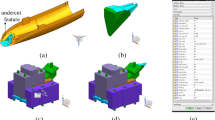Abstract
The design of a mould, which is manually performed, is time-consuming and quite complicated. This research presents a study on the procedures for automatic feature recognition to help in mould design. A hybrid representation approach is used in automatic feature recognition to extract geometric information from a feature to identify undercut features. Boundary representation is applied in the shape representation using topology and geometry. The proposed approach uses a face adjacency hypergraph to describe the shape of the undercut features by representing the relationships amongst the feature faces. Face-to-face composition is applied to represent the relationship between the main and the undercut features. Parts A, B, and C are created, and automatic feature recognition is used to classify the depression and protrusion features. Algorithms based on a heuristic rule are adopted to determine the optimal parting line and direction of the parts by comparing their feature’s geometric information. The automatic feature recognition approach identifies the shape of concave and convex features in accordance with the depression or protrusion of faces and the face adjacency relationship. This approach can be helpful in automatically creating the core and cavity. The proposed approach will help simplify the process and reduce the time for mould design. Therefore, this approach will significantly affect the increase in productivity in the manufacturing industry.
Access this chapter
Tax calculation will be finalised at checkout
Purchases are for personal use only
Similar content being viewed by others
References
Banerjee AG, Gupta SK (2007) Geometrical algorithms for automated design of side actions in injection moulding of complex parts. Comput Aided Des 39(10):882–897. https://doi.org/10.1016/j.cad.2007.05.014
Bok AY, Abu Mansor MS (2013) Generative regular-freeform surface recognition for generating material removal volume from stock model. Comput Ind Eng 64(1):162–178. https://doi.org/10.1016/J.CIE.2012.08.013
Bruzzone E, Floriani L De (1991) Extracting adjacency relations IPS from a modular boundary model. Comput Aided Des 23(5):344–355. https://doi.org/10.1016/0010-4485(91)90028-U
Cai N, Bendjebla S, Lavernhe S, Mehdi-Souzani C, Anwer N (2018) Freeform machining feature recognition with manufacturability analysis. Procedia CIRP 72:1475–1480. https://doi.org/10.1016/J.PROCIR.2018.03.261
Chakraborty P, Venkata Reddy N (2009) Automatic determination of parting directions, parting lines and surfaces for two-piece permanent molds. J Mater Process Technol 209(5):2464–2476. https://doi.org/10.1016/j.jmatprotec.2008.05.051
Falcidieno B (1989) Automatic recognition and representation of shape-based features in a geometric modeling system. Comput Vis Graph Image Process 48(1):93–123. https://doi.org/10.1016/0734-189X(89)90106-0
Fu MW, Fuh JYH, Nee AYC (1999) Undercut feature recognition in an injection mould design system. Comput Aided Des 31(12):777–790. https://doi.org/10.1016/S0010-4485(99)00070-6
Gao S, Shah JJ (1998) Automatic recognition of interacting machining features based on minimal condition subgraph. Comput Aided Des 30(9):727–739. https://doi.org/10.1016/S0010-4485(98)00033-5
Han J, Kang M, Choi H (2001) STEP-based feature recognition for manufacturing cost optimization. Comput Aided Des 33(9):671–686. https://doi.org/10.1016/S0010-4485(01)00071-9
Langerak TR (2010) Local parameterization of freeform shapes using freeform feature recognition. Comput Aided Des 42(8):682–692. https://doi.org/10.1016/j.cad.2010.02.004
Liu C, Perng D, Chen Z (1994) Automatic form feature recognition and 3D part reconstruction from 2D CAD data. Comput Ind Eng 26(4):689–707. https://doi.org/10.1016/0360-8352(94)90006-X
Md Yusof M, Abu Mansor MS (2017) Automatic core and cavity generation for 3D CAD model using normal vector and scanning ray approaches. ARPN J Eng Appl Sci 12(14):4250–4254
Md Yusof M, Abu Mansor MS (2018a) Undercut feature recognition for core and cavity generation. IOP Conf Ser Mater Sci Eng 290(1): 012070. https://doi.org/10.1088/1757-899X/290/1/012070
Md Yusof M, Abu Mansor MS (2018b) Alternative method to determine parting direction automatically for generating core and cavity of two-plate mold using B-rep of visibility map. Int J Adv Manuf Technol 96(9–12): 3109-3126. https://doi.org/10.1007/s00170-018-1695-5
Nasr ESA, Khan AA, Alahmari AM, Hussein HMA (2014) A feature recognition system using geometric reasoning. Procedia CIRP 18:238–243. https://doi.org/10.1016/j.procir.2014.06.138
Ratzlaff J, Giovannetti T (2016) Injection molding. In: Handbook of industrial polyethylene technology, vol 2. https://doi.org/10.1002/9781119159797.ch15
Sakkalis T, Shen G. Patrikalakis NM (2000) Representational validity of boundary representation models, Comput Aided Design 32(12):719–726. https://doi.org/10.1016/S0010-4485(00)00047-6
Sundararajan V, Wright PK (2004) Volumetric feature recognition for machining components with freeform surfaces. Comput Aided Des 36(1):11–25. https://doi.org/10.1016/S0010-4485(03)00065-4
Wu MC, Liu CR (1996) Analysis on machined feature recognition techniques based on B-rep. Comput Aided Design 28(8):603–616. https://doi.org/10.1016/0010-4485(95)00075-5
Ye XG, Fuh JYH, Lee KS (2001) A hybrid method for recognition of undercut features from moulded parts. Comput Aided Des 33(14):1023–1034. https://doi.org/10.1016/S0010-4485(00)00138-X
Acknowledgements
This research is supported by the Ministry of Higher Education Malaysia and Universiti Sains Malaysia under the Fundamental Research Grant Scheme (FRGS) (Reference No. 6071369).
Author information
Authors and Affiliations
Corresponding author
Editor information
Editors and Affiliations
Rights and permissions
Copyright information
© 2020 Springer Nature Singapore Pte Ltd.
About this paper
Cite this paper
Tan, J.X., Abu Mansor, M.S. (2020). Construction of a Hybrid Geometric Model for an Injection Mould Using CAD/CAM System. In: Emamian, S.S., Awang, M., Yusof, F. (eds) Advances in Manufacturing Engineering. Lecture Notes in Mechanical Engineering. Springer, Singapore. https://doi.org/10.1007/978-981-15-5753-8_30
Download citation
DOI: https://doi.org/10.1007/978-981-15-5753-8_30
Published:
Publisher Name: Springer, Singapore
Print ISBN: 978-981-15-5752-1
Online ISBN: 978-981-15-5753-8
eBook Packages: EngineeringEngineering (R0)




